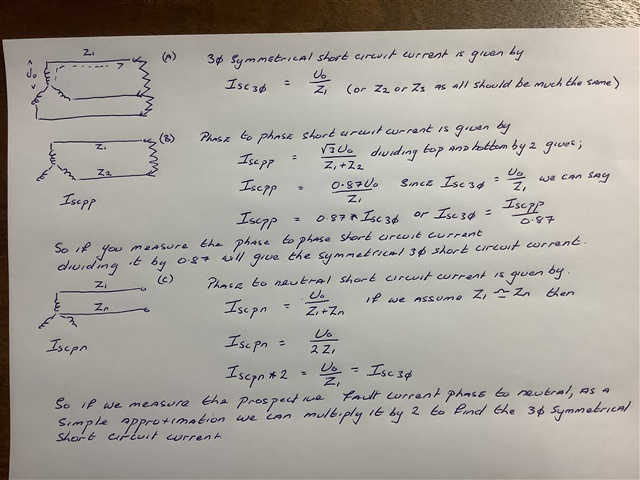Are there any ElectricalOM users on here who can explain setting up the source details?
Thank you.
Not understanding this at all. For a 69KvA tx with a 6% impedance, I make the short circuit KVA to be 1150 and the KA circa 1.7.
How is the source Iscc the same as the line neutral in a three-phase set up?
It looks like the programme is not user friendly for a simple design where source details and cable details between source and installation are unknown.
How is the source Iscc the same as the line neutral in a three-phase set up?
I see that now. Since the three phase short circuit is Uoxcmax / Zp, the values will be the same at the source terminals. Presumably, when one inserts the characteristics of the cable from source to installation origin, the values given at the installation origin will reflect the intervening conductor impedances.
I assume you could therefore start with any appropriate standard tx and then input a connecting cable that will attenuate fault levels to a desired value.
I'm not sure that it does. I'm working from test results from the service head...or at least as close as possible to there. When putting all the parameters in the Isc is still 10.17... when I think it should be 20.34. (I may be wrong, that's why I'm posting on here). However, the downstream DB calls for the same short circuit currents when dealing with 3 phase MCCBs and single phase MCCBs. Hence why I'm posting for advice. I can't see how you would input information relating to the installation origin. NB. Lyle I've back calculated an input kVA of 69 to give a 100A per phase supply, and (I think from memory 0.98 Z% ) to give 10.17 kA single phase short circuit current.

I hope you don’t think this patronising. It is an attempt to explain why we can make approximations of the three-phase symmetrical fault current by measuring the fault current between two phases and dividing by 0.87 or, as many do, by measuring the fault current between phase and neutral and multiplying by 2.
The key thing is accepting the premise that the three-phase symmetrical fault current is given by dividing the phase voltage by the impedance of one phase only.
Note that the phase voltage is 230v for a 400/230v system. Likely if design calculations were being made the voltage would be lifted by 10% to 253v.
No doubt in a real fault situation, strange things will happen to thwart neat text book explanations.
Hi Richard,
Apologies, but i'm still not sure what it is you haven't been able to achieve with the software. I would input the values in the boxes indicated by Spencer Henry . The only item that i have not input is the 69kVA source capacity, because you have not stated this to be the case. You can use any value in the source capacity box to check agains the supply limit - e.g. an agreed maximum demand value. If you do not click the "calculate short circuit" button then the fault current values will not update from your manually entered values and the calculations will be undertaken based on your values.
When i do this at my end the values propogate through the calculation.
Hi Richard,
Apologies, but i'm still not sure what it is you haven't been able to achieve with the software. I would input the values in the boxes indicated by Spencer Henry . The only item that i have not input is the 69kVA source capacity, because you have not stated this to be the case. You can use any value in the source capacity box to check agains the supply limit - e.g. an agreed maximum demand value. If you do not click the "calculate short circuit" button then the fault current values will not update from your manually entered values and the calculations will be undertaken based on your values.
When i do this at my end the values propogate through the calculation.
We're about to take you to the IET registration website. Don't worry though, you'll be sent straight back to the community after completing the registration.
Continue to the IET registration site